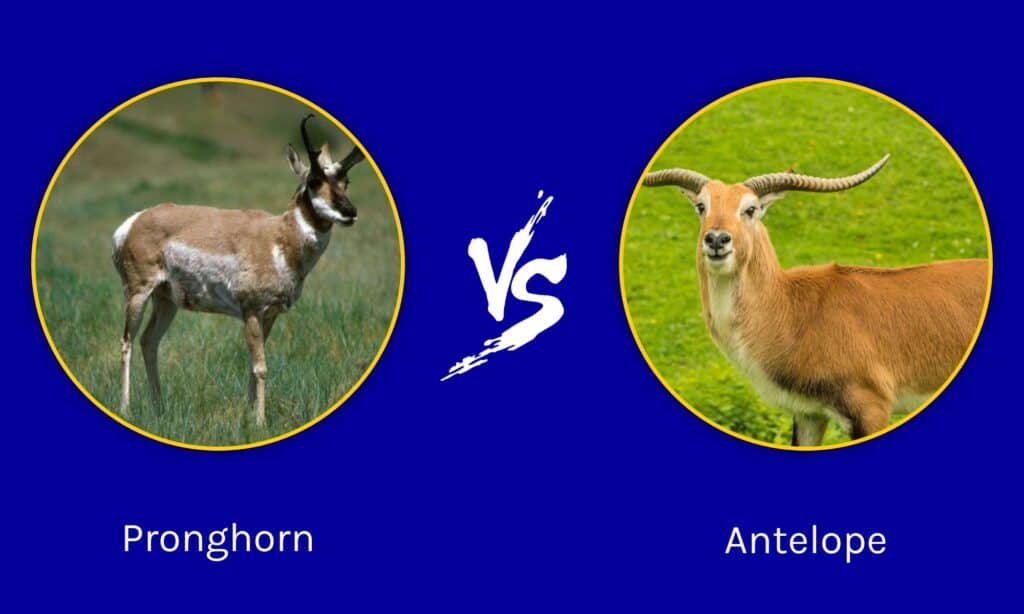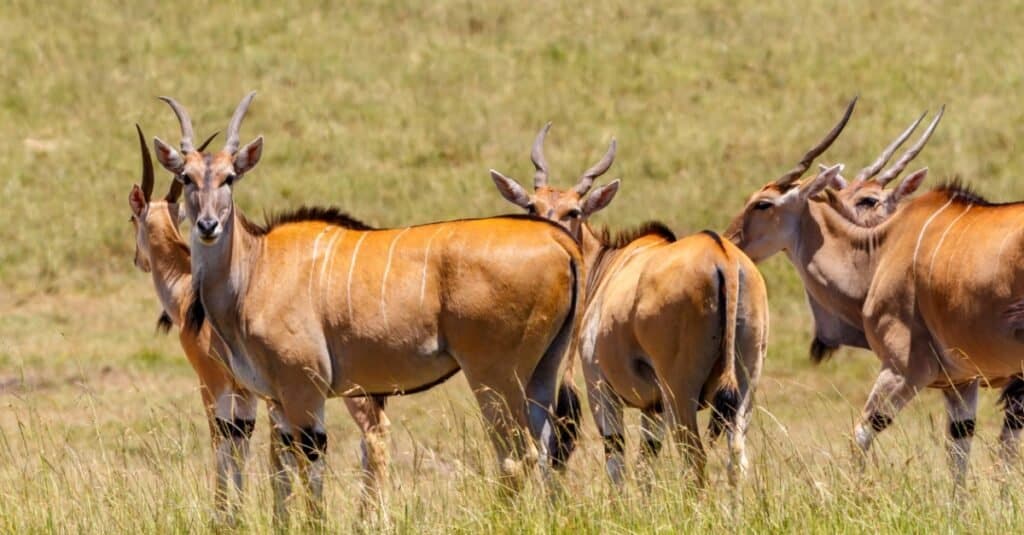The pronghorn is indigenous to North America, while the antelope can be found in Africa and parts of Eurasia. In short, the chances of seeing one species next to the other in the wild are quite slim. However, given that the pronghorn is often called the American antelope, it is certainly worth making a comparison between the two.
As you might have seen from the representative images for each species, the two are quite similar in aspects. Characteristics-wise, on the other hand, you’ll see that the antelope comes in a variety of colors and sizes, unlike the pronghorn – you’ll find out why below.
If you want to find out more about the two closely related species of the clade Pecora, then make sure to read the showcased details – size, family, horns, range, and more.
Comparing Pronghorns vs Antelopes

| Key Features | Pronghorn | Antelope |
|---|---|---|
| Size | 90 pounds in weight32 to 41 inches at the shoulder4.3 ft to 4.11 ft long | 110 lbs to 2,000 lbs in weight3ft to 5ft at the shoulder |
| Family | Antilocapridae | Bovidae |
| Speed | 55 – 60mph | 55 mph |
| Horn Morphology | Horns branch in prongs (rarely occurs in females); Horns of up to 9.8 inches long for males and 4.7 inches long for females. | Horns do not branch; they usually curve backwardHorns of up to 28 inches long. |
| Keeps Antlers All Year | Horns are shed and regrow each year (however, their core is permanent). | Horns grow continuously |
| Number of Species | One | 91 species |
| Range | Western and central North America | Africa and Eurasia |
The Key Differences Between Pronghorns and Antelopes
The key differences between pronghorns and antelopes are size, family, horn morphology, number of species, and range.
Essentially, the main and most important difference between the pronghorn and antelope species is the fact that the term antelope refers to a wide variety of species of animals. In contrast, the pronghorn is a simple mammal species.
Another main difference is in the coloring of the two. The pronghorn features white fur across the throat, belly, breast, sides, and rumps. The antelope species are usually brown and may feature white spots – this differs, however, from species to species.
Let’s now move from general aspects to more in-depth information regarding these two beautiful animals.
Pronghorn vs Antelope: Size

Pronghorns can grow up to 4.11 feet long from nose to tail.
©BGSmith/Shutterstock.com
Pronghorns can grow up to 4.11 feet long from nose to tail and weigh around 88 to 143 pounds. Female pronghorns are just as long but lighter – 75 to 106 pounds. The animal is fairly tall, standing up to 41 inches high at the shoulder.
The story is different in the case of antelopes. Due to the variety of species, some antelope can grow as tall as 5.10 feet at the shoulder and some as short as 9.5 inches at the shoulder. The same applies to weight – some species can have up to 2,100 pounds.
Pronghorn vs Antelope: Family
The pronghorn is part of the Antilocapridae family, close relatives of the giraffids. The pronghorn, known as Antilocapra americana, is the only living species of the Antilocapridae family. The species is characterized by small ruminant mammals and is known for its resemblance with antelopes.
The antelope is part of the Bovidae family, and it’s a close relative of bison, cattle, buffalo, and goat-antelopes. The family is characterized by ruminant mammals, the same as the pronghorn but cloven-hoofed. It is known for its variety and coloration.
Pronghorn vs Antelope: Speed
At a glance, both the pronghorn and the antelope are capable of the same speed – around 55-60 mph. Adult pronghorns can achieve speeds of up to 60 mph and are close contenders to the cheetah for the fastest land animal in the world title – the cheetah has a speed of 61 mph. Pronghorns are known for their increased endurance.
Fast species of antelope can achieve a similar speed as the pronghorn. The fastest is the goitered gazelle of Asia, capable of up to 60 mph, followed closely by the African springbok. The latter can be as fast as 55 mph but in short bursts only.
Pronghorn vs Antelope: Horn Morphology

The antelope’s horns are simple – they don’t branch and have only one point.
©iStock.com/EcoPic
Both species feature horns, unlike deer with antlers. The pronghorn horn has both a permanent core and a sheath that is regrown annually. Multiple keratinous sheaths can grow on the core of the horn. Each sheath is branched, featuring a tine that points forward. The sheath averages 9.8 inches, including the prong. Female pronghorns have smaller horns – an average of 4.7 inches. This volume of the Journal of Mammalogy provides an amazing insight into the growth and casting of horns by pronghorns.
The antelope’s horns are simple – they don’t branch and have one point only. Horn shape and size vary in antelopes due to many species. Some have simple spikes pointing outward from their heads, while some have horns that curve or point backward, or are straight, twisted, spiraled, curved, etc. Antelopes keep their horns throughout the year.
Pronghorn vs Antelope: Number of Species
Among the biggest differences is the number of species. There are roughly 91 species of antelope scattered across Africa and Eurasia (most originate from Africa). On the other hand, the pronghorn is the only living species in its family.
There are, however, five types of pronghorn in North America – the common pronghorn, Mexican pronghorn, Baja California pronghorn, Sonoran pronghorn, and Oregon pronghorn. These are subspecies of pronghorn.
Pronghorn vs Antelope: Range

Antelopes are scattered throughout parts of Eurasia and Africa.
©iStock.com/TT
The range of antelope is larger than that of pronghorn. Antelope are scattered throughout parts of Eurasia and Africa. No antelope species can be found in the Americas or Europe – only some subspecies.
It is often believed that antelopes can be found in America due to the pronghorn’s resemblance to the species. After all, the pronghorn is called the American antelope, among other names such as prairie antelope, prong buck, and pronghorn antelope. Pronghorns can be found only in the interior of western and central North America.
It can be challenging to tell the two species apart. This is because the antelope family encompasses a wide variety of animals – with a great selection of colors, horn structures, heights, weights, etc. Fortunately, you will rarely find them in the same place – maybe just at the zoo.
The photo featured at the top of this post is © BGSmith/Shutterstock.com
Thank you for reading! Have some feedback for us? Contact the AZ Animals editorial team.






